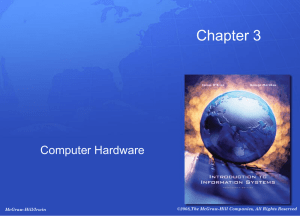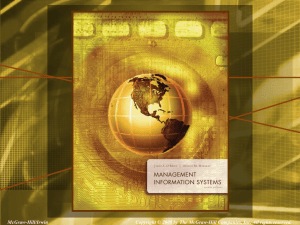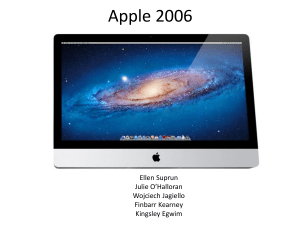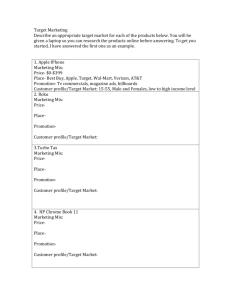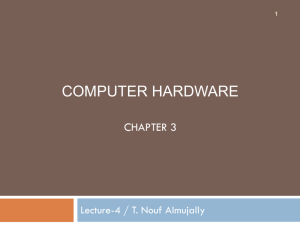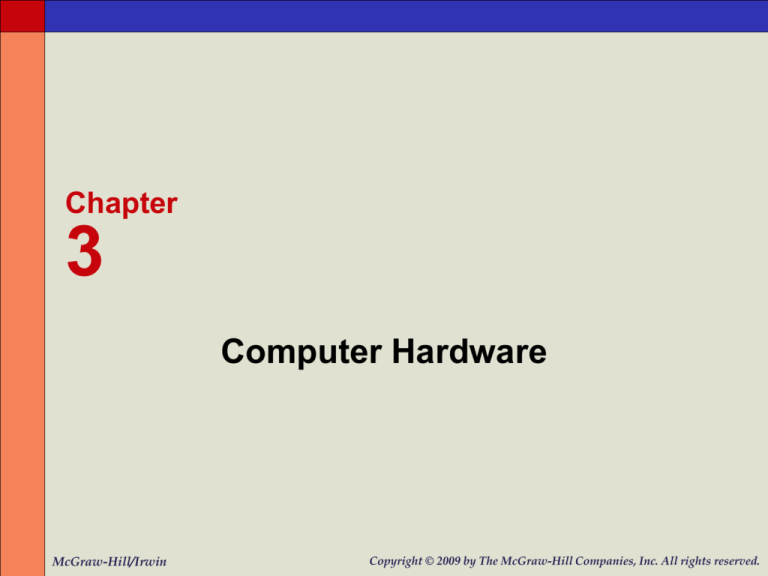
Chapter
3
Computer Hardware
McGraw-Hill/Irwin
Copyright © 2009 by The McGraw-Hill Companies, Inc. All rights reserved.
Learning Objectives
• Understand the history and
evolution of computer hardware
• Identify the major types and uses of
microcomputer, midrange, and
mainframe computer systems
• Outline the major technologies and
uses of computer peripherals for
input, output, and storage
3-2
Learning Objectives
• Identify and give examples of the
components and functions of a
computer system
• Identify the computer systems and
peripherals you would acquire or
recommend for a business of your
choice, and explain the reasons for
your selection.
3-3
Case 1: IBM, Wachovia, and Paypal
• Researchers at the Cancer Institute in New Jersey have been
using grid computing technologies to convert hundreds of
thousands of images of cancerous tissues and cells into digital
images.
• Once the images are digitized, the grid can check the
accuracy of the digital information to ensure that the bits and
bytes are translating into real diagnoses.
• IBM researchers and a team of doctors are building a
database of digital images they hope will enable oncologists to
diagnose and treat cancer patients faster and with more
success.
• Grid computing technologies avoid the need for expensive,
dedicated hardware by distributing the processing load among
commodity-priced equipment.
3-4
Case Study Questions
1. Applications for grid computing in
this case include medical diagnosis
and financial transaction
processing. What other areas do
you think would be well suited to the
use of grid computing and why?
Provide several examples from
organizations other than those
included in the case.
3-5
Case Study Questions
2. New Jersey works by digitalizing
medical diagnoses on the World
Community Grid (WCG). What are
the advantages and disadvantages
of relying on a volunteer based
network such as this? Provide
examples of both. Visit the Web
site of the WCG to inform your
answer.
3-6
Case Study Questions
3. IBM, Wachovia, and Paypal are
arguably large organizations. However,
several vendors have started offering
computing power for rent to smaller
companies, using the principles
underlying grid computing. How could
small and medium companies benefit
from these technologies? Search the
Internet for these offerings to help you
research your answer.
3-7
Pre-Computer Calculations
• Counting on fingers and toes
• Stone or bead abacus
– Calculate comes from calculus, the Latin
word for stone
• 1642: first mechanical adding machine
– Invented by Blaise Pascal
– Wheels moved counters
– Modified in 1674 by Von Leibnitz
• Age of industrialization
– Mechanical loomed used punch cards
3-8
Early Computing
• 19th Century
– Charles Babbage proposed the Analytical
Engine, which could calculate, store values in
memory, perform logical comparisons
– Never built because of lack of electronics
• 1880s
– Hollerith’s punched cards used to record
census data using On/Off patterns
– The holes turned sensors On or Off when run
through tabulating machine
– This company became the foundation for IBM
3-9
Electronic Computers
• 1946 - First Generation Computer
–
–
–
–
–
ENIAC
Programmable
5000 calculations per second
Used vacuum tubes
Drawbacks were size and processing ability
• 1950s
– ENIAC replaced by UNIVAC 1, then the
IBM 704
– Calculations jumped to 100,000 per second
3-10
Waves of Computing
• Late 1950s - Second Generation
– Transistors replaced vacuum tubes
– 200,000 to 250,000 calculations per second
• Mid-1960s - Third Generation
– Integrated circuitry and miniaturization
• 1971 - Fourth Generation
– Further miniaturization
– Multiprogramming and virtual storage
• 1980s - Fifth Generation
– Millions of calculations per second
3-11
Microcomputers
• 1975
– ALTAIR flicking switches
• 1977
– Commodore and Radio Shack produce
personal computers
• 1979
– Apple computer, the fastest selling PC thus far
• 1982
– IBM introduced the PC, which changed the
market
3-12
Categories of Computer Systems
3-13
Microcomputer Systems
• Usually called a personal computer or PC
• Computing power now exceeds that of the
mainframes of previous generations
• Relatively inexpensive
• Are the networked professional workstations
used by business processions
• Versions include hand-held, notebook, laptop,
tablet, portable, desktop, and floor-standing
3-14
Recommended PC Features
3-15
Microcomputer Uses
• Workstations
– Supports have mathematical computer and
graphics display demands
– CAD, investment and portfolio analysis
• Network Servers
– More powerful than workstations
– Coordinates telecommunications and
resource sharing
– Supports small networks and Internet or
intranet websites
3-16
Corporate PC Criteria
• Solid performance at a reasonable
price
• Operating system ready
• Connectivity
– Network interface cards
or wireless capabilities
3-17
Information Appliances
• Hand-held microcomputer devices
• Known as personal digital assistants (PDAs)
– Web-enabled PDAs use touch screens, handwriting
recognition, or keypads
– Mobile workers use to access email or the Web,
exchange data with desktop PCs or servers
– Latest entrant is the BlackBerry
• PDAs include
– Video-game consoles
– Cellular and PCS phones
– Telephone-based home email appliances
3-18
Midrange Systems
• High-end network servers that handle largescale processing of business applications
• Not as powerful as mainframes
– Less expensive to buy, operate, and maintain
• Often used to manage
– Large Internet websites
– Corporate intranets and extranets
– Integrated, enterprise-wide applications
• Used as front-end servers to assist mainframes
with telecommunications and networks
3-19
Mainframe Computer Systems
• Large, fast, powerful computer systems
– Large primary storage capacity
– High transaction processing
– Handles complex computations
• Widely used as superservers for…
– Large client/server networks
– High-volume Internet websites
• Becoming a popular computing platform for…
– Data mining and warehousing
– Electronic commerce applications
3-20
Supercomputer Systems
• Extremely powerful systems designed for…
– Scientific, engineering, and business applications
– Massive numeric computations
• Markets include…
– Government research agencies
– Large universities
– Major corporations
• Uses parallel processing
– Billions to trillions of operations per second (gigaflops
and teraflops)
– Costs $5 to $50 million
3-21
Computer System Concept
• A system of hardware devices organized
by function
– Input
• Keyboards, touch screens, pens, electronic mice,
optical scanners
• Converts data into electronic form for entry into
computer system
– Processing
• Central Processing Unit (CPU)
• CPU subunits: arithmetic-logic and control unit
3-22
Computer System Concept
– Output
• Video display units, printers, audio response units,
and so on
• Converts electronic information into humanintelligible form
– Storage
• Primary storage (memory)
• Secondary storage (disk drives)
– Control
• CPU controls other components of the system
3-23
Computer System Concept
3-24
Computer Processing Speeds
• Early computers
– Milliseconds (thousandths of a second)
– Microseconds (millionths of a second)
• Current computers
– Nanoseconds (billionth of a second)
– Picoseconds (trillionth of a second)
• Program instruction processing speeds
– Megahertz (millions of cycles per second)
– Gigahertz (billions of cycles per second)
• Commonly called the “clock speed”
3-25
Computer Processing Speeds
• Throughput
– The ability to perform useful computation or
data processing assignments during a given
period
• Speed is dependant on…
– Size of circuitry paths (buses) that
interconnect microprocessor components
– Capacity of instruction processing registers
– Use of high-speed cache memory
– Use of specialized microprocessor, such as
math coprocessor
3-26
Moore’s Law
• A doubling in the number of transistors
per integrated circuit every 18 to 24
months
– Originally observed in 1965, it holds true
today
• Common corollary of Moore’s Law…
– Computing prices will be cut in half every 18
to 24 months
– This has been consistently accurate
– Applies to cost of storage as well
3-27
Moore’s Law
3-28
Case 2: Apple, Microsoft, IBM, and Others
• The WIMP - Windows, Icons, Menus, and Pointing
devices have dominated computing for 15 years.
• New human interface technologies will revolutionize the
way we interact with computers.
• Microsoft is working with Starwood Hotels & Resorts to
introduce surface computing where a hotel guest using a
virtual concierge in the lobby can manipulate maps,
photos, restaurant menus, and theater information.
• Some researchers say that a logical extension of touch
technology is gesture recognition, by which a system
recognizes hand or finger movements across a screen
or close to it without requiring an actual touch.
3-29
Case Study Questions
1. What benefits may Starwood
Hotels derive from the introduction
of touch-screen technology, as
noted in the case? What possible
disruptions may occur as a result?
Provide several examples of each.
3-30
Case Study Questions
2. Bill Buxton of Microsoft stated that “Touch
now may be where the mouse was in
about 1983.” What do you make of his
comments, and what do you think it would
take for touch technology to displace the
WIMP interface? Justify your answer.
3. Is advanced touch-screen technology
really a solution in search of a problem?
Do you agree with this statement? Why or
why not?
3-31
Peripherals
• Peripheral is a generic name for all input,
output, and secondary storage devices
– Parts of the computer system, but not the CPU
– Are all online devices
• Online devices
– Separate from the CPU, but electronically
connected to and controlled by it
• Offline devices
– Separate from and not under the control of the
CPU
3-32
Peripherals Advice
3-33
Input Technologies
• Keyboard
– Still most widely used input device
• Graphical User Interface (GUI)
– Icons, menus, windows, buttons, bars
– Selected with pointing devices
• Electronic Mouse
– Most popular pointing device
– Pressing mouse buttons initiates
activity represented by the icon
selected
3-34
Input Technologies
• Trackball
– Stationary device, similar to mouse
– Roller ball moves cursor on screen
• Pointing Stick
– Small eraser-head device
embedded in keyboard
– Cursor moves in the
direction of the pressure
placed on the stick
3-35
Input Technologies
• Touchpad
– Small, rectangular, touch-sensitive surface
– Usually on keyboard
– Cursor moves in direction your finger moves
• Touch Screen
– Use computer by touching
screen
– Screen emits a grid of
infrared beams, sound waves,
or electric current
– Grid is broken when screen is touched
3-36
Pen-Based Computing
• Used in Tablet PCs and PDAs
– Pressure-sensitive layer, similar
to touch screen, under liquid
crystal display screen
– Software digitizes handwriting,
hand printing, and hand drawing
3-37
Speech Recognition Systems
• Speech be the future of data entry
– Easiest, most natural means of human
communication
• Recognizing speech patterns
– Discrete required pauses between
each word
– Continuous speech recognition
software (CSR) recognized
continuous, conversationally paced
speech
3-38
Speech Recognition Software
• Speech recognition systems digitize, analyze,
and classify speech and sound patterns
– Compares to a database of sound patterns in its
vocabulary
– Passes recognized words to the application software
– Typically requires voice recognition training
• Speaker-independent voice recognition systems
– Allows computer to recognize words from a voice it has
never heard before
– Typically used in voice-messaging computers
3-39
Optical Scanning
• Devices read text or graphics and
convert them into digital input for a
computers
– Enables direct entry of data from source
documents
• A document management library
system
– Scans documents, then organizes and
stores them for easy reference or
retrieval
3-40
Optical Scanning
• Scanners
– Compact desktop models are popular for low
cost and ease of use
– Larger, more expensive flatbed scanners are
faster and provide high-resolution color
scanning
• Optical Character Recognition (OCR)
– Software that reads characters and codes
– Used to real merchandise tags, sort mail,
score tests
– Optical scanning wands read bar codes
3-41
Other Input Technologies
• Magnetic Stripe
– Reads the magnetic stripe on credit cards
• Smart Cards
– Microprocessor chip and memory on credit
card
– Use more in Europe than in the U.S.
• Digital Cameras
– Allows you to shoot, store, and download
photos or full-motion video with audio into the
PC
– Images and audio can then be edited or
enhanced
3-42
Other Input Technologies
• Magnetic Ink Character Recognition
(MICR)
– Used by banks to magnetically read
checks and deposit slips
– Requires an iron oxide-based ink
– Reader-sorter equipment magnetizes
the ink, then passes it under a reading
head to sense the signal
3-43
Output Technologies
• Video Displays
– Cathode-ray tube (CRT)
– Liquid crystal displays (LCDs)
• Active matrix and dual scan
– Plasma displays
• Used in large TVs and flat-panel monitors
• Printed Output
– Inkjet printers spray ink on a page
– Laser printers use an electrostatic process
similar to a photocopying machine
3-44
Storage Tradeoffs
3-45
Computer Storage Fundamentals
• Uses a two-state or binary
representation of data
– On or Off
– On represents the number 1
– Off represents the number 0
• Data are processed and stored in
computer systems through the
presence or absence of On/Off
signals
3-46
Bit and Byte
• Bit
– Short for binary digit
– Smallest element of data
– Either zero or one
• Byte
– Group of eight bits, which operate as a
single unit
– Represents one character or number
3-47
Representing Characters in Bytes
3-48
Using Binary Code to Calculate
3-49
Storage Capacity Measurement
•
•
•
•
•
Kilobyte (KB): one thousand bytes
Megabyte (MB): one million bytes
Gigabyte (GB): one billions bytes
Terabyte (TB): one trillion bytes
Petabyte (PB): one quadrillion bytes
3-50
Direct and Sequential Access
• Direct or Random Access
– Directly store and retrieve data
– Each storage position has a unique address and can
be accessed in the same length of time
– Semiconductor memory chips, magnetic disks
• Sequential Access
– Data is stored and retrieved sequentially
– Must be accessed in sequence by searching through
prior data
– Magnetic tape
3-51
Direct and Sequential Access
3-52
Semiconductor Memory
• Microelectronic semiconductor
memory chips are used for primary
storage
– Advantages: small size, fast, shock
and temperature resistance
– Disadvantages: volatility; must have
uninterrupted electric power or loses
memory
3-53
Types of Semiconductor Memory
• Random Access Memory (RAM)
– Most widely used primary storage medium
– Volatile memory
– Read/write memory
• Read-Only Memory (ROM)
– Permanent storage
– Can be read, but not overwritten
– Frequently used programs burnt into chips
during manufacturing process
– Called firmware
3-54
Flash Drives
• Sometimes referred to as a jump
drive
– Uses a small chips containing
thousands of transistors
– Can store data for virtually
unlimited periods without power
– Easily transported and highly
durable
– Storage capacity of up to 1 GB
– Plugs into any USB port
3-55
Magnetic Disks
• Used for secondary storage
– Fast access and high capacity
– Reasonable cost
3-56
Types of Magnetic Disks
• Floppy Disks (diskettes)
– Magnetic disk inside a plastic jacket
• Hard Disk Drives (hard drives)
– Magnetic disk, access arms, and
read/write heads in sealed module for
stable environment
– Fixed or removable
– Capacity from several hundred MBs to
hundreds of GBs
3-57
RAID Storage
• Redundant Arrays of Independent Disks
– Disk arrays of hard disk drives
– Provides virtually unlimited online storage
– Combines from 6 to more than 100 small hard
disk drives into a single unit
– Data are accessed in parallel over multiple
paths from many disks
– Redundant storage of data on several disks
provides fault-tolerant capacity
– Storage area networks can interconnect many
RAID units
3-58
Magnetic Tape
• Secondary storage
– Tape reels, cassettes, and cartridges
– Used in robotic, automated drive
assemblies
– Archival and backup storage
– Lower-cost storage solution
3-59
Optical Disks
3-60
Uses of Optical Disks
• Image processing
– Long-term storage of historical image files
– Storage of scanned documents
• Publishing medium
– Allows fast access to reference materials
– Catalogs, directories, and so on
• Interactive multimedia applications
– Video games, educational videos, and so on
3-61
Radio Frequency Identification (RFID)
• One of the newest and fastest growing
storage technologies
– System for tagging and identifying mobile
objects
– Used with store merchandise, postal packages,
casino chips, pets
– Special reader allows objects to be tracked as
they move from place to place
– Chips half the size of a grain of sand
• Passive chips derive power from reader
signal
– Active chips are self-powered
3-62
RFID Versus Bar Coding
• RFID
– Scans from greater distance
– Can store data
– Allows more information to be tracked
• Privacy concerns
– Invisible nature of the system
– Capacity to transmit fairly
sophisticated messages
3-63
Case 3: Northrup Grumman, Boeing,
and Others:
• When it comes to wireless technologies used to
empower a mobile workforce, ROI seems to be
a minor issue.
• For many companies like Northrup Grumman,
Boeing, and others cost isn’t the issue but total
connectivity of the workforce is.
• The challenge is delivering the information that
fit on small LCD screens of these mobile
devices.
• Mobile computing capabilities have become “a
critical component of a company’s success.”
3-64
Case Study Questions
1. What are several major business
benefits that organizations can
realize by connecting all of their
employees with wireless mobile
devices?
2. Are the CIOs in the case saying
that ROI is not important when
deploying mobile computing
devices? Explain your response.
3-65
Case Study Questions
3. What are several challenges that
employees and organizations face
in connecting their employees with
wireless mobile devices? Do these
challenges outweigh the
connectivity benefits you outlined
earlier? Why or why not?
3-66
Case 4: Apple Inc.
• In the microcomputer market, Apple shrank from an
industry leader to a niche player because it designed
closed systems with proprietary hardware and software.
• The runaway success of Apple’s iPod has helped boost
the market share of the iMac and other desktop and
portable computers in Apple’s Mac lineup.
• Since the arrival of the iPod, Apple’s share of the
desktop and portable computer market in the US has
almost doubled, reaching just under 6 percent in early
2006.
• Apple’s strategy of closed system of the iPod really paid
off.
3-67
Case Study Questions
1. Do you agree with the sources in this case that
Apple will continue to dominate the digital
music market for years to come? Why or why
not?
2. Can the key technology and business
strategies Steve Jobs implemented with the
closed system of the iPod be applied
successfully to the iMac and other Apple
closed-system computer products? Defend
your answer with several examples of what
could or could not be accomplished for Apple’s
computer product line
3-68
Case Study Questions
3. Will the cachet of the iPod and the
capabilities of Boot Camp and the
Leopard version of Apple’s OS X
continue to lure more first-time
computer buyers and Windows PC
users to the Mac lineup of
desktops and portables? Why or
why not?
3-69

